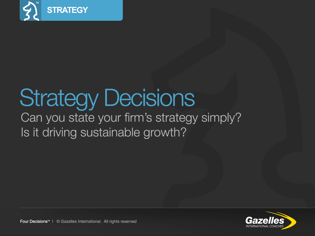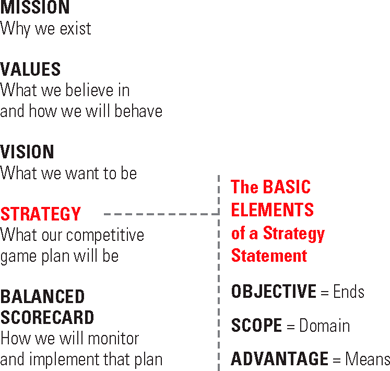 What’s your Strategy?
What’s your Strategy?
If I asked anyone on your team, from the people who interact daily with your customers to your leadership team members, how would they respond?
How many similar answers do you feel you would get?
An Inc. Magazine survey revealed 92% of CEOs believe their leadership teams agrees with and can communicate their strategy.
In Reality: The same survey discovered: ONLY 2% OF THE LEADERSHIP TEAMS COULD!
NOTE: That’s just the leadership team. What do you feel it would be for your company overall?
In our Public and Private Rockefeller Habits and Scaling up Workshops we typically ask the attendees to write down in a few sentences what their company’s strategy is. Seldom is there agreement. In most cases it’s vague, or there is no consistency in the answer even among leadership teams that have worked together for years.
The scary thing is if your leadership team isn’t in agreement on your strategy how would it be possible for the rest of your players to be in agreement or perhaps even aware what your strategy is. If they’re not aware and indeed if you’re not aware than what message are you sending to your customers?
You can be sure the message your customers are getting isn’t consistent, let alone on target with what you hope to be achieving.
According to Wikipedia: The Tower of Babel (/ˈbæbəl/ or /ˈbeɪbəl/; Hebrew: מִגְדַּל בָּבֶל, Migddal Bāḇēl) is a story told in the Book of Genesis of the Tanakh (also referred to as the Hebrew Bible or the Old Testament) meant to explain the origin of different languages. According to the story, a united humanity of the generations following the Great Flood, speaking a single language and migrating from the east, came to the land of Shinar (Hebrew: שנער). There they agreed to build a city and tower; seeing this, God confounded their speech so that they could no longer understand each other and scattered them around the world.
Is your business confounded by different languages for your strategy?
How can that possibly be?
What have you failed to achieve if everyone in your organization is confused or unaware of your strategy?
Positioning Systems/Scaling Up/Rockefeller Habits offers several tools and resources to help provide clarity on your Strategy. One such opportunity is the Scaling Up Workshop in Cedar Rapids on Wednesday, November 11th. You’ll learn how to develop your strategy by beginning to create your One Page Strategic Plan. You learn how to Scale Up your business. Download our Scaling Up Workshop flyer or register to attend. We absolutely guarantee to help you meet and exceed your business expectations for 2016!
One exercise that has been very helpful for my customers to identify your strategy is from HBR article Can You Say What Your Strategy Is? (FYI there is a fee or subscription required to download the article)
The article intention is to create a 35 word vision for your Strategy by developing three elements for your strategy: Objective, Scope, and Advantage.
Defining the Objective
The first element of a strategy statement is the one that most companies have in some form or other. Unfortunately, the form is usually wrong. Companies tend to confuse their statement of values or their mission with their strategic objective. A strategic objective is not, for example, the platitude of “maximizing shareholder wealth by exceeding customer expectations for _______ [insert product or service here] and providing opportunities for our employees to lead fulfilling lives while respecting the environment and the communities in which we operate.” Rather, it is the single precise objective that will drive the business over the next five years or so.  (See picture at right: “A Hierarchy of Company Statements.”) Many companies do have—and all firms should have—statements of their ultimate purpose and the ethical values under which they will operate, but neither of these is the strategic objective.
(See picture at right: “A Hierarchy of Company Statements.”) Many companies do have—and all firms should have—statements of their ultimate purpose and the ethical values under which they will operate, but neither of these is the strategic objective.
Organizational direction comes in several forms. The mission statement is your loftiest guiding light—and your least specific. At Positioning Systems we’ve refined this into Your Core Purpose or Brand Ideal and have developed several tools to help you develop a clear Purpose for your Business.
As you work your way down the hierarchy, the statements become more concrete, practical, and ultimately unique. No other company will have the same strategy statement, which defines your competitive advantage, or balanced scorecard, which tracks how you implement your particular strategy.
The mission statement/Core Purpose spells out the underlying motivation for being in business in the first place—the contribution to society that the firm aspires to make. (An insurance company, for example, might define its mission as providing financial security to consumers.) Such statements, however, are not useful as strategic goals to drive today’s business decisions. Similarly, it is good and proper that firms be clear with employees about ethical values. But principles such as respecting individual differences and sustaining the environment are not strategic. They govern how employees should behave (“doing things right”); they do not guide what the firm should do (“the right thing to do”).
Firms in the same business often have the same mission. (Don’t all insurance companies aspire to provide financial security to their customers?) They may also have the same values. They might even share a vision: an indeterminate future goal such as being the “recognized leader in the insurance field.” However, it is unlikely that even two companies in the same business will have the same strategic objective. Indeed, if your firm’s strategy can be applied to any other firm, you don’t have a very good one.
It is always easy to claim that maximizing shareholder value is the company’s objective. In some sense all strategies are designed to do this. However, the question to ask when creating an actionable strategic statement is: Which objective is most likely to maximize shareholder value over the next several years? (Growth? Achieving a certain market share? Becoming the market leader?) The strategic objective should be specific, measurable, and time bound. It should also be a single goal. It is not sufficient to say, “We seek to grow profitably.” Which matters more—growth or profitability? A salesperson needs to know the answer when she’s deciding how aggressive to be on price. There could well be a host of subordinate goals that follow from the strategic objective, and these might serve as metrics on a balanced scorecard that monitors progress for which individuals will be held accountable. Yet the ultimate objective that will drive the operation of the business over the next several years should always be clear.
The HBR article asks these questions, and if you’ve asked and answered these questions as you proceeded through this article you can understand how challenging and influential the questions and answers can be for your business.
Next blog we’ll ask and define the Objective, Scope and Advantage to help you make progress on your Strategy.





.jpeg?width=150&height=135&name=Hand%20with%20marker%20writing%20the%20question%20Whats%20Next_%20(1).jpeg)

